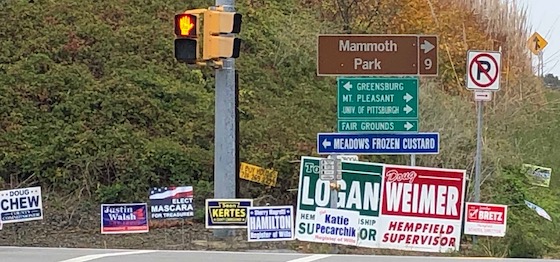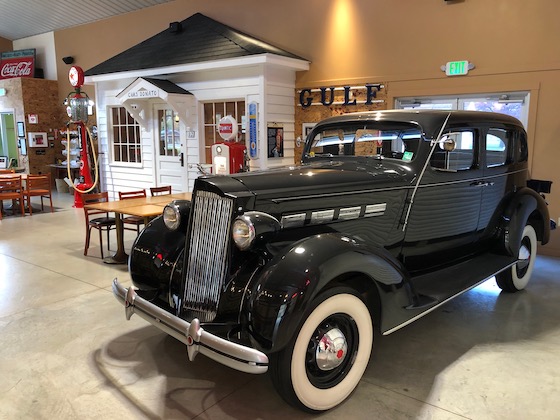Memo From Frank
One great part of the Holiday Season is the opportunity for personal contact with friends and family. All too often, in a modern America, we have substituted human contact for on-line shopping, texting, and postings on Facebook. And that’s a shame. We all need an outlet for social interaction. And in many ways, billboards offer the owner just that outlet. Between talking to property owners to build a sign on their property and advertisers to rent the billboard faces, outdoor advertising is definitely a great refuge for “people persons”. And on that note, we’d like to thank everyone who reads this newsletter, participates in our forum, and is a member of our circle of friends and acquaintances that advances the narrative of investing in the outdoor advertising industry. So let’s raise a glass of eggnog and toast the Holiday Season. We’re glad you’re a part of ours.
Huge Money And Not A Clue

There’s a definite learning curve between the American public and the billboard industry. The average American has absolutely no clue as to the money that billboards can produce – or that there is a “billboard industry” at all. How is this possible?
Nobody knows how a billboard is built
Billboards come in four formats: 1) wooden telephone pole 2) steel I-beam 3) steel monopole and 4) vinyl wallscape. Steel signs require sophisticated engineering to make them stand up, while the others are so simplistic that any hobbyist could figure it out. Nevertheless, most Americans have absolutely ho idea what these four types of signs even are.
Nobody knows how much they cost to build
Wooden signs and vinyl wallscapes cost around $3,000 to $5,000 while steel signs cost around ten times more. But, just as they are ignorant on the types of signs, the typical American is also clueless regarding the costs of construction.
Nobody knows how much they rent for
This is one category where Americans are completely lost – what billboard signs actually rent for. They think it’s a few hundred dollars when the truth is that many signs rent for 10 times that much. And there are a few signs in some markets, such as Chicago, where the signs can rent for $10,000+ per month. The bottom line is that the rental figures are huge.
Nobody knows the profitability percentage on that rent
Virtually zero Americans know what the actual profit and loss statement looks like for a billboard. Signs have just a few cost centers: 1) ground rent 2) electricity 3) repair & maintenance 4) taxes 5) insurance 6) the cost to install the advertisements. All of these things combined equal about 40% of the revenue, so the profitability of most signs is around 60 cents on the dollar. That’s very high.
But they do pay attention to what goes on them
Despite their total lack of knowledge concerning billboards, the one item most Americans know is what billboards say. That’s because the American public is commuting back and forth to work an average of 30 minutes+ each way, and they pass literally hundreds of billboards as they go and have nothing else to look at.
Conclusion
Americans know less about billboards than almost any other part of U.S. culture. They are clueless on rents, prices and profitability. And that’s what creates the opportunity for those who do know.
Why The Highway Beautification Act Really Created This Industry

In the beginning, there were just random signs built by various advertisers all over the nation’s road systems. Then Ladybird Johnson and the Highway Beautification Act of 1965. With one stroke of the pen, LBJ had created the billboard industry – which is exactly what he didn’t want to happen. It was one of the great mistakes in American political history.
The economic principal of supply and demand
We have all heard of the theorem of “supply and demand”. The rules is simply that when the demand for something outstrips the supply, then prices go up, and when demand is lower than supply then prices go down. It’s one of the most fundamental axioms in economics.
Why there’s no profitability when there’s unrestricted supply
Back in the early days of billboards, any advertiser could place them anywhere they wanted, so there was no value in the signs. The supply was infinite and always higher than demand, as any advertiser could build them anywhere. If you look at photos of old Route 66 form the 1950s, for example, you’ll see that the road is packed with signs, each fighting for attention. Back in those days, the ground rent for a billboard could be as little as a can of oil per year, since in the absence of restrictions there was no value to any location.
How the Highway Beautification Act created that restriction
When Ladybird Johnson set about trying to find a way to end the proliferation of signs, she decided that the key was to restrict where they could go. She thought that the government should take over the right to build a billboard to a distance of 660’ from the right-of-way. She engineered a system of zonings and spacings that became required to build signs. And, most importantly, she took away the supply side of building signs, which had been infinite. With the supply interrupted, it made the ad rents and values of billboards skyrocket.
Why the billboard industry has no risk of deregulation
The U.S. government has made mistakes before, such as the regulation of the airline and trucking industries and then, when they realized they had screwed up, they de-regulated those industries. But they can’t do that with billboards, as that would lead to infinite supply again and their stance regarding the environment will not allow it. So they’re stuck, And 55 years later it’s pretty much a lost cause.
Why the Highway Beautification Act stands as the perfect example of why some laws don’t work right
The U.S. government passes laws all the time. Some work and others don’t. And some end up with unintended consequences. That’s what happened with the billboard industry. The very law that was supposed to destroy it and shut it down actually created attractive favorable supply and demand and the rest was history.
Conclusion
Today’s billboard industry owes a debt of gratitude to Ladybird Johnson and the Highway Beautification Act of 1965. And she would have hated that fact.
The Ultimate Billboard Boot Camp
![]() How to Find a Billboard Location
How to Find a Billboard Location
![]() How to Buy a Billboard
How to Buy a Billboard
![]() How to Build a Billboard
How to Build a Billboard
![]() How to Operate a Billboard
How to Operate a Billboard
![]() How to Rent Ad Space on a Billboard
How to Rent Ad Space on a Billboard
![]() How to Sell a Billboard
How to Sell a Billboard
Get Your Copy Now!
Why You Want To Put Your Billboard In The Property’s Corner

There are many places where you can install a billboard on a piece of land. But the best choice is to put the sign in the property corner. Why is that?
Protection from future development
When you put the billboard in the corner, it gives the sign owner the best chance of longevity. Most billboard ground leases allow for the property owner to terminate the lease in the event of development, and most raw land eventually finds a use and many developed properties have new uses over time. The best protection is to simply stay out of the game and be way off in the corner where there is nothing new to build.
Operational factors on the ground
Another important consideration is the operational requirements of what is located on the property. If the land is being used as a gas station, there are constant cars coming in and out. If the use is a restaurant, there are issues regarding parking and delivery of food products by truck. The one place that’s completely out of the way is always the corner of the property – far away from all the action.
Operational factors in the air
Sometimes there are problems with the relationship between the billboard and what’s underneath that relates simply to overhanging the property. For example, if there’s a busy parking lot, bird droppings from birds that roost in the sign can be a problem. Another issue can be casting shade. And then there’s the continual problem with the sign potentially blocking visibility of the property sign.
Conclusion
The best place to position a billboard is in the corner of the land. It’s always been that way, and it makes complete sense. If you want to maximize the longevity of any sign, then you should consider placing it in the most out of the way place possible: the corner.
Why I Love The Billboard Lifestyle

I have personally always enjoyed driving America’s highways and getting to know the many cities and towns along the way. This has given me access to my hobby of exploring local antique stores and museums. Here’s an interesting place I ran into recently: The Lincoln Highway Museum. Apparently, the Lincoln Highway was the northern road that ran parallel to Route 66. While Route 66 went from Chicago to Santa Monica, California, the Lincoln Highway went from New York City to San Francisco. This museum features some odd items such as an original motor lodge of the 1930s as well as a gas station from the same period and a diner that serves every visitor a piece of apple pie. If you enjoy exploring America, then you will really like the “billboard lifestyle”.
